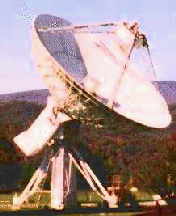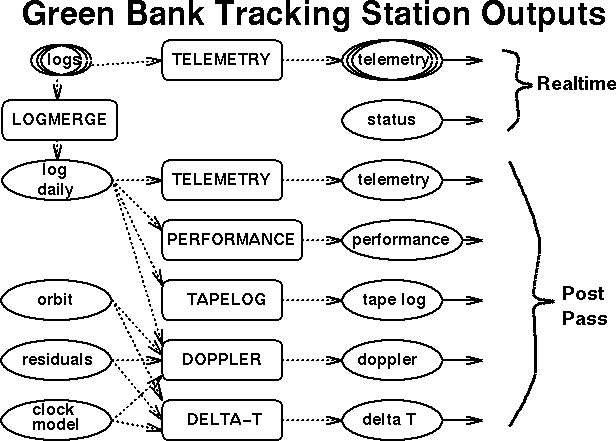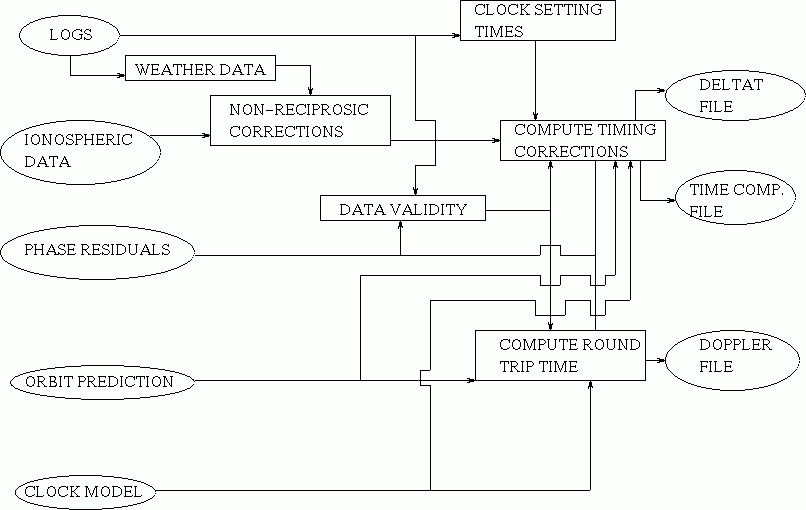 Station Software Outputs
Station Software Outputs
Two types of station outputs are generated during the tracking
passes, satellite telemetry data files and station status files.
After the tracking passes, five additional outputs are produced.
Only one station output, the status file, is generated directly
by the realtime system. All other outputs are generated by
the offline system.
Below, a schematic diagram shows the relationships of
output programs and the output files.

Doppler and Delta-T
The Doppler and Delta-T processing is complicated, but the
two programs share many common parts.
Below, the schematic diagram shows the relationships of the
data validation and modelling parts of the Doppler and Delta-T
programs.

Doppler
The doppler file is produced after a given tracking pass has ended. This
file contains information used for orbit determination by the JPL Navigation
Team.
GBES memo 66 describes how the doppler data are derived from the
measured TWT phase residual data.
The JPL orbit determination (doppler) file is the
subject of an agreement between NRAO Green Bank and JPL.
The station agreed to produce the doppler file according to
the JPL Track 2-80 document (not available on-line). Some
modifications were made to the specification.
A GBES memo
describes the general plan for doppler data transfer.
The users guide for the offline program
doppler describes the arguments supplied to the program by the operators.
DeltaT
The deltaT file is produced after a given tracking pass has ended. There
are two files produced by "deltaT" - the delta file (or time corrections
file) and the time components file. These files contain the corrections
to the recorded time on the VLBA tapes for the satellite to be applied
at the correlator.
The latest copy of the
deltaT file specification can be found here.
The
users guide
for the offline program
deltaT describes the
arguments supplied to the program by the operators.
Clock Model
The tracking station clock is driven by a maser located approximately
2 km away in the
Green Bank Interferometer control building. The clock model consists
of monitoring of both the maser and the station time versus GPS time.
The users guide for determining the clock model is
here .
Telemetry Headers
The satellite telemetry header file is generated every 15 minutes.
This file contains the HALCA downlink information for the previous
15 minutes. The telemetry file contains a wide varity of information
including the measurements of satellite total power detectors,
temperatures of hardware modules, the uplink power parameters and
state of the satellite observing system.
These telemetry header files are made available automatically via
anonymous
ftp during the tracking pass.
After the tracking pass, a single file is created,
containing all telemetry data collected during the tracking pass.
The latest copy of the
Telemetry Header Format specification
is kept on-line.
Tape Log
The tape log contains a description of the location of the
data on the tapes, data flags and calibration tone measurements.
The tapeLog program takes only station log files as input and
produces a single output file per tracking pass per tape drive used
during the pass. The tape log files are retrieved by the VSOG
and merged with other tape logs for the same experiments.
The correllators may also directly read the tape logs.
The
users guide
for the offline program
tapeLog describes the
arguments supplied to the program by the operators.
The file
specification is kept on-line. The description
references input specifications for the
Mitaka,
VLBA
and
Canadian (S2)
Correlators.
Performance Log
The performance log is an ascii, time-tagged, summary of events
and measurements made during the tracking pass.
The
specification
for the performance log describes the logical content of the file.
The
users guide
for the offline program
performanceLog describes the
arguments supplied to the program by the operators.
Return to the Station Software Guide.
The National Radio Astronomy Observatory
(NRAO)
is a facillity of the
National Science Foundation
operated under cooperative agreement by
Associated Universities, Inc.
glangsto@nrao.edu tminter@nrao.edu
Last update: 97 July 3
 Station Software Outputs
Station Software Outputs Station Software Outputs
Station Software Outputs
